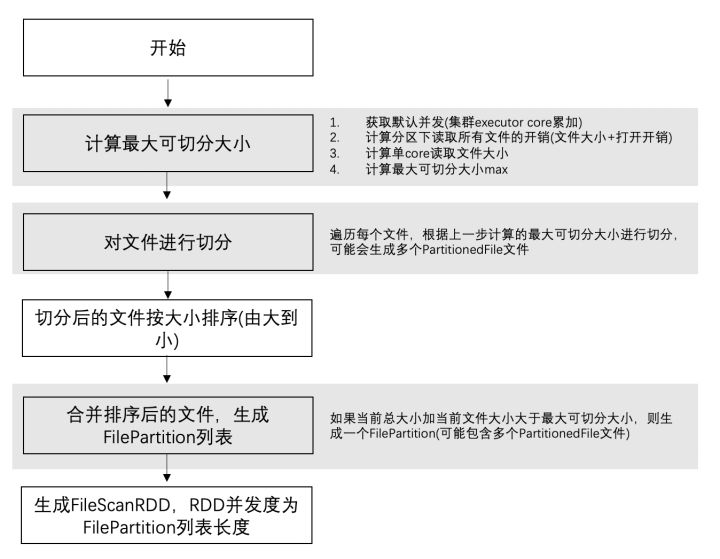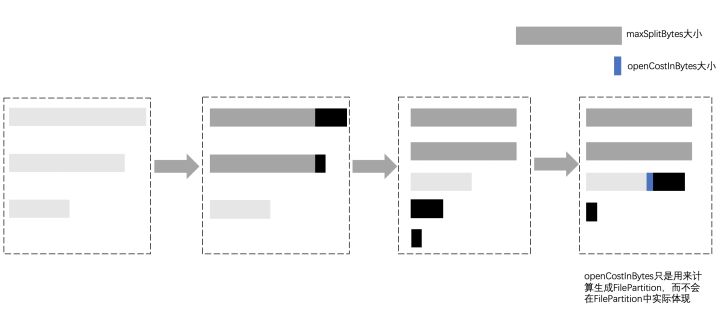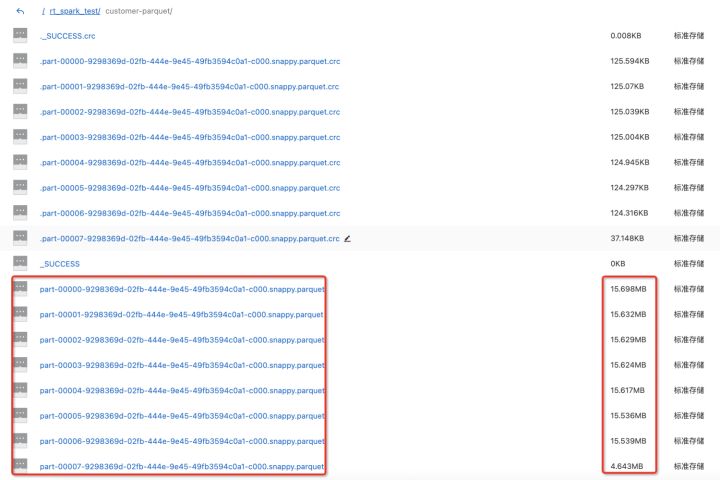引言
典型的Spark作业读取位于OSS的Parquet外表时,源端的并发度(task/partition)如何确定?特别是在做TPCH测试时有一些疑问,如源端扫描文件的并发度是如何确定的?是否一个parquet文件对应一个partition?多个parquet文件对应一个partition?还是一个parquet文件对应多个partition?本文将从源码角度进行分析进而解答这些疑问。
分析
数据源读取对应的物理执行节点为FileSourceScanExec,读取数据代码块如下
lazy val inputRDD: RDD[InternalRow] = {val readFile: (PartitionedFile) => Iterator[InternalRow] =relation.fileFormat.buildReaderWithPartitionValues(sparkSession = relation.sparkSession,dataSchema = relation.dataSchema,partitionSchema = relation.partitionSchema,requiredSchema = requiredSchema,filters = pushedDownFilters,options = relation.options,hadoopConf = relation.sparkSession.sessionState.newHadoopConfWithOptions(relation.options))val readRDD = if (bucketedScan) {createBucketedReadRDD(relation.bucketSpec.get, readFile, dynamicallySelectedPartitions,relation)} else {createReadRDD(readFile, dynamicallySelectedPartitions, relation)}sendDriverMetrics()readRDD}主要关注非bucket的处理,对于非bucket的扫描调用createReadRDD方法定义如下
/*** Create an RDD for non-bucketed reads.* The bucketed variant of this function is [[createBucketedReadRDD]].** @param readFile a function to read each (part of a) file.* @param selectedPartitions Hive-style partition that are part of the read.* @param fsRelation [[HadoopFsRelation]] associated with the read.*/private def createReadRDD(readFile: (PartitionedFile) => Iterator[InternalRow],selectedPartitions: Array[PartitionDirectory],fsRelation: HadoopFsRelation): RDD[InternalRow] = {// 文件打开开销,每次打开文件最少需要读取的字节 val openCostInBytes = fsRelation.sparkSession.sessionState.conf.filesOpenCostInBytes// 最大切分分片大小val maxSplitBytes =FilePartition.maxSplitBytes(fsRelation.sparkSession, selectedPartitions)logInfo(s"Planning scan with bin packing, max size: $maxSplitBytes bytes, " +s"open cost is considered as scanning $openCostInBytes bytes.")// Filter files with bucket pruning if possibleval bucketingEnabled = fsRelation.sparkSession.sessionState.conf.bucketingEnabledval shouldProcess: Path => Boolean = optionalBucketSet match {case Some(bucketSet) if bucketingEnabled =>// Do not prune the file if bucket file name is invalidfilePath => BucketingUtils.getBucketId(filePath.getName).forall(bucketSet.get)case _ =>_ => true}// 对分区下文件进行切分并按照从大到小进行排序val splitFiles = selectedPartitions.flatMap { partition =>partition.files.flatMap { file =>// getPath() is very expensive so we only want to call it once in this block:val filePath = file.getPathif (shouldProcess(filePath)) {// 文件是否可split,parquet/orc/avro均可被splitval isSplitable = relation.fileFormat.isSplitable(relation.sparkSession, relation.options, filePath)// 切分文件PartitionedFileUtil.splitFiles(sparkSession = relation.sparkSession,file = file,filePath = filePath,isSplitable = isSplitable,maxSplitBytes = maxSplitBytes,partitionValues = partition.values)} else {Seq.empty}}}.sortBy(_.length)(implicitly[Ordering[Long]].reverse)val partitions =FilePartition.getFilePartitions(relation.sparkSession, splitFiles, maxSplitBytes)new FileScanRDD(fsRelation.sparkSession, readFile, partitions)}可以看到确定最大切分分片大小maxSplitBytes对于后续切分为多少个文件非常重要,其核心逻辑如下
def maxSplitBytes(sparkSession: SparkSession,selectedPartitions: Seq[PartitionDirectory]): Long = {// 读取文件时打包成最大的partition大小,默认为128MB,对应一个block大小val defaultMaxSplitBytes = sparkSession.sessionState.conf.filesMaxPartitionBytes// 打开每个文件的开销,默认为4MBval openCostInBytes = sparkSession.sessionState.conf.filesOpenCostInBytes// 建议的(不保证)最小分割文件分区数,默认未设置,从leafNodeDefaultParallelism获取// 代码逻辑调用链 SparkSession#leafNodeDefaultParallelism -> SparkContext#defaultParallelism// -> TaskSchedulerImpl#defaultParallelism -> CoarseGrainedSchedulerBackend#defaultParallelism// -> 总共多少核max(executor core总和, 2),最少为2val minPartitionNum = sparkSession.sessionState.conf.filesMinPartitionNum.getOrElse(sparkSession.leafNodeDefaultParallelism)// 总共读取的大小val totalBytes = selectedPartitions.flatMap(_.files.map(_.getLen + openCostInBytes)).sum// 单core读取的大小val bytesPerCore = totalBytes / minPartitionNum// 计算大小,不会超过设置的128MBMath.min(defaultMaxSplitBytes, Math.max(openCostInBytes, bytesPerCore))}对于PartitionedFileUtil#splitFiles,其核心逻辑如下,较为简单,直接按照最大切分大小切分大文件来进行分片
def splitFiles(sparkSession: SparkSession,file: FileStatus,filePath: Path,isSplitable: Boolean,maxSplitBytes: Long,partitionValues: InternalRow): Seq[PartitionedFile] = {if (isSplitable) {// 切分为多个分片(0L until file.getLen by maxSplitBytes).map { offset =>val remaining = file.getLen - offsetval size = if (remaining > maxSplitBytes) maxSplitBytes else remainingval hosts = getBlockHosts(getBlockLocations(file), offset, size)PartitionedFile(partitionValues, filePath.toUri.toString, offset, size, hosts)}} else {Seq(getPartitionedFile(file, filePath, partitionValues))}}在获取到Seq[PartitionedFile]列表后,还并没有完成对文件的切分,还需要调用FilePartition#getFilePartitions做最后的处理,方法核心逻辑如下
def getFilePartitions(sparkSession: SparkSession,partitionedFiles: Seq[PartitionedFile],maxSplitBytes: Long): Seq[FilePartition] = {val partitions = new ArrayBuffer[FilePartition]val currentFiles = new ArrayBuffer[PartitionedFile]var currentSize = 0L/** Close the current partition and move to the next. */def closePartition(): Unit = {if (currentFiles.nonEmpty) {// Copy to a new Array.// 重新生成一个新的PartitionFileval newPartition = FilePartition(partitions.size, currentFiles.toArray)partitions += newPartition}currentFiles.clear()currentSize = 0}// 打开文件开销,默认为4MBval openCostInBytes = sparkSession.sessionState.conf.filesOpenCostInBytes// Assign files to partitions using "Next Fit Decreasing"partitionedFiles.foreach { file =>if (currentSize + file.length > maxSplitBytes) {// 如果累加的文件大小大于的最大切分大小,则关闭该分区,表示完成一个Task读取的数据切分closePartition()}// Add the given file to the current partition.currentSize += file.length + openCostInBytescurrentFiles += file}// 最后关闭一次分区,文件可能较小closePartition()partitions.toSeq}可以看到经过这一步后,会把一些小文件做合并,生成maxSplitBytes大小的PartitionFile,这样可以避免拉起太多task读取太多小的文件。
生成的FileScanRDD(new FileScanRDD(fsRelation.sparkSession, readFile, partitions))的并发度为partitions的长度,也即最后Spark生成的Task个数
override protected def getPartitions: Array[RDDPartition] = filePartitions.toArray
整体流程图如下图所示

拆分、合并过程如下图所示

实战
对于TPCH 10G生成的customer parquet表
https://oss.console.aliyun.com/bucket/oss-cn-hangzhou/fengzetest/object?path=rt_spark_test%2Fcustomer-parquet%2F
共8个Parquet文件,总文件大小为113.918MB

Spark作业配置如下,executor只有1core
conf spark.driver.resourceSpec=small;
conf spark.executor.instances=1;
conf spark.executor.resourceSpec=small;
conf spark.app.name=Spark SQL Test;
conf spark.adb.connectors=oss;
use tpcd;
select * from customer order by C_CUSTKEY desc limit 100;根据前面的公式计算
defaultMaxSplitBytes = 128MB
openCostInBytes = 4MB
minPartitionNum = max(1, 2) = 2
totalBytes = 113.918 + 8 * 4MB = 145.918MB
bytesPerCore = 145.918MB / 2 = 72.959MB
maxSplitBytes = 72.959MB = Math.min(defaultMaxSplitBytes, Math.max(openCostInBytes, bytesPerCore))得到maxSplitBytes为72.959MB,从日志中也可看到对应大小

经过排序后的文件顺序为(00000, 00001, 00002, 00003, 00004, 00006, 00005, 00007),再次经过合并后得到3个FilePartitioned,分别对应
- FilePartitioned 1: 00000, 00001, 00002
- FilePartitioned 2: 00003, 00004, 00006
- FilePartitioned 3: 00005, 00007
即总共会生成3个Task
从Spark UI查看确实生成3个Task

从日志查看也是生成3个Task



变更Spark作业配置,5个executor共10core
conf spark.driver.resourceSpec=small;
conf spark.executor.instances=5;
conf spark.executor.resourceSpec=medium;
conf spark.app.name=Spark SQL Test;
conf spark.adb.connectors=oss;
use tpcd;
select * from customer order by C_CUSTKEY desc limit 100;根据前面的公式计算
defaultMaxSplitBytes = 128MB
openCostInBytes = 4MB
minPartitionNum = max(10, 2) = 10
totalBytes = 113.918 + 8 * 4MB = 145.918MB
bytesPerCore = 145.918MB / 10 = 14.5918MB
maxSplitBytes = 14.5918MB = Math.min(defaultMaxSplitBytes, Math.max(openCostInBytes, bytesPerCore))查看日志

此时可以看到14.5918MB会对源文件进行切分,会对00001, 00002,00003,00004,00005,00006进行切分,切分成两份,00007由于小于14.5918MB,因此不会进行切分,经过PartitionedFileUtil#splitFiles后,总共存在7 * 2 + 1 = 15个PartitionedFile
- 00000(0 -> 14.5918MB), 00000(14.5918MB -> 15.698MB)
- 00001(0 -> 14.5918MB), 00001(14.5918MB -> 15.632MB)
- 00002(0 -> 14.5918MB), 00002(14.5918MB -> 15.629MB)
- 00003(0 -> 14.5918MB), 00003(14.5918MB -> 15.624MB)
- 00004(0 -> 14.5918MB), 00004(14.5918MB -> 15.617MB)
- 00005(0 -> 14.5918MB), 00005(14.5918MB -> 15.536MB)
- 00006(0 -> 14.5918MB), 00006(14.5918MB -> 15.539MB)
- 00007(0 -> 4.634MB)
经过排序后得到如下以及合并后得到10个FilePartitioned,分别对应
- FilePartitioned 1: 00000(0 -> 14.5918MB)
- FilePartitioned 2: 00001(0 -> 14.5918MB)
- FilePartitioned 3: 00002(0 -> 14.5918MB)
- FilePartitioned 4: 00003(0 -> 14.5918MB)
- FilePartitioned 5: 00004(0 -> 14.5918MB)
- FilePartitioned 6: 00005(0 -> 14.5918MB)
- FilePartitioned 7: 00006(0 -> 14.5918MB)
- FilePartitioned 8: 00007(0 -> 4.634MB),00000(14.5918MB -> 15.698MB)
- FilePartitioned 9: 00001(14.5918MB -> 15.632MB),00002(14.5918MB -> 15.629MB),00003(14.5918MB -> 15.624MB)
- FilePartitioned 10: 00004(14.5918MB -> 15.617MB),00005(14.5918MB -> 15.536MB),00006(14.5918MB -> 15.539MB)
即总共会生成10个Task
通过Spark UI也可查看到生成了10个Task

查看日志,000004(14.5918MB -> 15.617MB),00005(14.5918MB -> 15.536MB),00006(14.5918MB -> 15.539MB)在同一个Task中

00007(0 -> 4.634MB),00000(14.5918MB -> 15.698MB)

00001(14.5918MB -> 15.632MB),00002(14.5918MB -> 15.629MB),00003(14.5918MB -> 15.624MB)在同一个Task中

总结
通过源码可知Spark对于源端Partition切分,会考虑到分区下所有文件大小以及打开每个文件的开销,同时会涉及对大文件的切分以及小文件的合并,最后得到一个相对合理的Partition。
原文链接
本文为阿里云原创内容,未经允许不得转载。



















